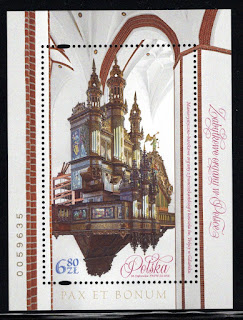The Malaysian postal service issued this stamp celebrating the St George Anglican Church in Georgetown (Pulau Pinang, or just Pinang, or Penang) in 2019. It is part of a series of stamps noting various religious structures in that nation. The stamp shows the iconic exterior of the facility; the selvage includes an image of a new pipe organ by the Mander firm of Great Britain.Pinang may refer to the Malaysian state, Pinang, or to the Pinang Island, though they appear to be essentially one and the same. The church is the largest in South-East Asia.
The British East India Company seized the bit of land that includes Georgetown in the late 1700's. It was a British enclave that affected British characteristics for many years. The church of St George was begun in 1815 and consecrated in 1819. A pavilion was erected in 1886 in the lawn in front of the west end doors.
A new organ was installed by the Mander firm in 2018. The firm's website give s bit more history: the church was built by Indian convict laborers. The building was bombed in 1941 and looted. It was restored and re-opened in 1948. The first organ was a second-hand Bryceson instrument originally serving a church in Singapore. That was replaced in 1899 by a Forster and Andrews instrument. That organ received some work in 1931, but was then destroyed in the 1941 bombing. Electronic instruments served the church until 2017. The area in which the church is situated was declared a UNESCO World Heritage Site in 2008, and major restoration of the church was done again in 2009.
The Mander site gives some interesting details about the placement of the instrument in the church, as well as specification.
The sheet of stamps has 20 stamps arranged in four columns of five stamps each. There is narrow selvage on all sides, and a wider selvage dividing the four columns in the center. The organ, and church steeple, are shown there. Other religious buildings appear in the outer selvage. The stamps include an indication "4/5." I have not investigated yet, but I suspect that may relate to the stamps appearing in the series being produced by the postal authorities.


















